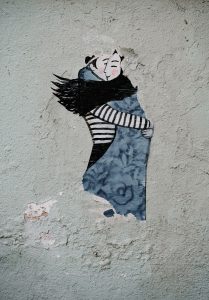Friday
Community Articles, Dharma TeachingsGood Society Part II: Feeling the Goodness

Photo by Annie Spratt on Unsplash
The second part of a two-part series by Shastri Russell Rodgers. For part one, click here.
In Part I of this two-part essay, we looked at the genetics behind the universal human impulse to create good society. The logic was this: everywhere there are humans, we form society. Therefore, it must be in our genes. The first part of this essay was basically a book review of Blueprint: The Evolutionary Origins of a Good Society, by Nicholas Christakis, a Yale professor.
Dr. Christakis proposes that encoded in our genes is a “social suite” that is common to all societies that are able to survive the test of time and circumstance. This “suite” includes : good leadership (and respect for that leadership), cooperation, learning from each other, befriending others, and valuing each person’s individuality. The genes encode possibilities: we make conscious choices as to whether to take advantage of these possibilities.
Buddhist practices that focus on kindness help to bring it to conscious awareness. Often, kindness practices focus on the heart. Sometimes, in visualization practices, there is a radiating sun, moon or seed syllable placed there. Here, radiation is a metaphor for kindness, and the visualization gives the mind something to focus on. The “Sadhana of Kindness” which is being practiced in many Shambhala Centres, has this basic structure. The post-meditation experience of this sadhana inspired me to write this essay.
Cultivating Kindness
Cultivating kindness may start out at a conceptual level. As we become sensitized to a practice, it enables us to see kindness operating naturally in the post meditation. Personally, I find that tuning into the undercurrent of kindness is a great way to take meditative mind off the cushion: the practice of noticing kind-awareness is warm and positive. Awareness of it is its own reward.
Kindness as an invisible undercurrent has a lot in common with what we have been taught about buddha nature/basic goodness. Basic goodness is connected to our innate ability to be aware and feel our surroundings. Experienced meditators recognize it as an unconditioned wakefulness that pops through. It doesn’t need a meditator-self to create it. Babies have wakefulness and are tuned to kindness. Dogs and cats are too. They don’t have to be taught. Awareness-kindness is naturally present.
Later, children can be taught to put kindness into action in specific ways: “please share the toys”. This is only possible if there is unconditioned awareness already there to work with. Awareness and kindness are in some sense different words for the same feeling. They have the same open, connected, engaged quality.
Although a robot could doubtless be given a set of governing rules and computations that would enable it to navigate in a grocery store, we humans seem to have something else happening. It isn’t particularly rules-based and it doesn’t need math. We seem to be navigating our social environment using something that is more related to just being conscious of others. We “feel” their presence and our awareness is drawn towards them. We are able to empathize with them. Because of this, we know how to be and how to act in the company of others. We respond to what feels “good”. We use this word a lot, but what do we mean by it?
Remember the last time you were in a grocery store. Think of how you were aware of people with carts coming towards you. Both of you created space and for each other. When you stopped to pick something off the shelf, you positioned your cart so that others could get by easily. If you forgot to leave space, you probably said “sorry. At the checkout, you waited in line patiently instead of butting in. You were conscious of the people in front and behind and were aware of the possibility of making contact. The clerk and you exchanged pleasantries. Underneath the stock pleasantries, you became aware of the clerk’s state of mind—were they tired, burnt-out, or relaxed and sensitive to your presence? You adjusted your behavior and speech accordingly. All of these actions are based on awareness and empathy: in other words, the invisible undercurrent of kindness. You didn’t have to pre-program it. It is natural and it feels right and good.
Part of being conscious is that one’s awareness is drawn to things in the world, and especially to other beings. Our minds have innate intelligence and curiosity. Our awareness is not cold like fluorescent lighting: there is warmth in that awareness. The wisdom holders in our tradition say that compassion is fundamentally awareness that hasn’t become dualistically self-centered.
When looking for kindness as an “invisible” undercurrent at the basis of society, it might be helpful to consider some of the enlightened buddha family styles of relating to others. “Buddha families” are a vajrayana description of how the basic mind expresses itself. Below are some examples of how we might manifest when self-centeredness is relaxed.
Buddha Family Styles of Subtle Kindness
Buddha: experiencing others from within a state of spaciousness
Vajra: seeing another’s behavior in clarity and perspective
Ratna: appreciating the richness someone’s basic goodness
Padma: openness and warm relationship. Playfulness.
Karma: seeing someone’s potential and interacting with it
If one was on the receiving end of one of these buddha family energies, you might be hard-pressed to express it in words. At the subtle level of undercurrent, we might just say that the interaction felt “good”.
We can also understand this kind of subtle kindness from the point of view of family. The word “kindness” is based on the word “kin”. When we recognize that others are conscious and aware, just like us, there is a feeling of kin-ship. We might even include animals as our kin. People who have pet dogs or cats often feel that they are part of the family. When we form that kind of bond, we become aware of animals and humans as conscious beings. This can extend to wild animals, too. We know that they experience contentment, pleasure and pain, just like us. The indigenous people who lived near my home town referred to the animals as “people”. There were deer people, beaver people, mosquito people and so on. Mountains and lakes had “spirits” too. In Shambhala Buddhism, we call it “drala. One can feel it. The connection feels “good”.
Laws
Often, laws are made around cases where kindness might be hijacked by self-centeredness. For instance, there are speed zones around schools, stop signs, traffic lights and so on. These are examples of codified kindness. Almost certainly a large part of the motivation behind these laws is to promote kindness to school children and other drivers. One could obey them literally and perhaps resentfully, but one could also allow the intention of the law to shape our feeling for the undercurrent. One could be aware of school children. and empathetic to other drivers at a four-way stop.
In my town of Nelson in British Columbia, pedestrians have the right of way at crosswalks. However, everyone knows that it would be foolhardy to step in front of an oncoming car without making eye contact with the driver. When the driver slows, usually the pedestrian acknowledges the courtesy of the driver with a friendly gesture of gratitude. These encounters may seem trivial, but taken together, they make the day a pleasant experience. Here, the rules have become channels for the expressions of kindness.
Joy
When we tune into the undercurrent of kindness, we can see how society is naturally created wherever there are humans. We can also see how enlightened society is possible. It’s part of our buddha nature. We know when our spirits uplifted by a sense of goodness. Maybe it’s in our DNA. Or, perhaps the scientific way of looking at subjective experience is a metaphor for something that actually can’t be pinned down.
When we meet a stranger coming the other way on a sidewalk, if there is a smile or a greeting, we feel something that can only be described as a small shot of joy. It may last for a few seconds, or several minutes or even hours. We get “juiced” by these random encounters. Society enables us to experience this juice, and social decorum provides the channels to express kindness to each other. We humans get depressed when we are denied our small shots of joy. It sounds like an addiction of sorts. Could it be that this is what prompts us to create “good”, or even “enlightened” society?
 Russell Rodgers lives in Nelson, a town of 10,000 in the mountains of British Columbia. It is a place of many dralas. He has practiced there since 1975 with a sangha that owns its own building and has about 50 members.
Russell Rodgers lives in Nelson, a town of 10,000 in the mountains of British Columbia. It is a place of many dralas. He has practiced there since 1975 with a sangha that owns its own building and has about 50 members.





Nov 22, 2019
Reply
Thank you Shastri Rodgers. Just today in Eugene, OR, walking on the sidewalk downtown, I passed a young man with long hair, beard, earbuds in, and expected no acknowledgement. When he looked up and gave me, a strange, 56-year-old woman, some eye contact and a nod of acknowledgement, it uplifted me on the spot. I felt warmth at the memory as I read this article. Thank you again!
Nov 16, 2019
Reply
Thank you Shastri Rodgers for your wise offerings. I do feel the goodness coming through and inspiring Shambhalians like me to continue to work for creating enlightened society or maybe islands of sanity here in Ecuador or wherever we may be!